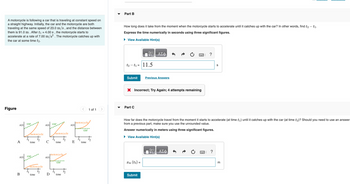
College Physics
11th Edition
ISBN: 9781305952300
Author: Raymond A. Serway, Chris Vuille
Publisher: Cengage Learning
expand_more
expand_more
format_list_bulleted
Concept explainers
Topic Video
Question
ANSWER BOTH PART B & C Please

Transcribed Image Text:A motorcycle is following a car that is traveling at constant speed on
a straight highway. Initially, the car and the motorcycle are both
traveling at the same speed of 23.0 m/s, and the distance between
them is 91.0 m. After t₁ = 4.00 s, the motorcycle starts to
accelerate at a rate of 7.00 m/s². The motorcycle catches up with
the car at some time t2.
Figure
x(1) car
ZZE
motorcycle
с time
A
car
x(1)
motorcycle
time
motorcycle
car
x(1)
BE
motorcycle
time
D time
car
x(1)
motorcycle
car
1 of 1
E time
Part B
How long does it take from the moment when the motorcycle starts to accelerate until it catches up with the car? In other words, find t2 - t₁.
Express the time numerically in seconds using three significant figures.
► View Available Hint(s)
t₂-t₁= 11.5
Submit
Part C
17 ΑΣΦ
X Incorrect; Try Again; 4 attempts remaining
xm (t₂) =
Previous Answers
Submit
How far does the motorcycle travel from the moment it starts to accelerate (at time t₁) until it catches up with the car (at time t₂)? Should you need to use an answer
from a previous part, make sure you use the unrounded value.
Answer numerically in meters using three significant figures.
► View Available Hint(s)
?
VE ΑΣΦ
S
2 ?
m
Expert Solution
This question has been solved!
Explore an expertly crafted, step-by-step solution for a thorough understanding of key concepts.
This is a popular solution
Trending nowThis is a popular solution!
Step by stepSolved in 4 steps with 4 images

Knowledge Booster
Learn more about
Need a deep-dive on the concept behind this application? Look no further. Learn more about this topic, physics and related others by exploring similar questions and additional content below.Similar questions
- find C=A+4B if A=(3i-j+2k) and B=(i-2j+k)arrow_forwarddetermine the magnitude and orientation theta of FB so that the resultant force is directed along the positive y axis and has a magnitude of 1500N.arrow_forwardPlease help with the solution to this problem using (km/s). I know we will use Hohmann Transfer and a combined plane change. In the opening scene of the movie “Gravity” Dr Ryan Stone (Sandra Bullock) and Matt Kowalsky (George Clooney) are required to transit from the Hubble Space Telescope (Altitude 600 km, 28.5 degree inclination) to the International Space Station (Altitude 400 km, 51.6 degree inclination) using nothing but their Manned Maneuvering Units (MMU). An MMU has a delta V capability of about 30 m/s, and it would be impossible to perform this maneuver with so little delta V, but… a.) How much delta V would be required for this maneuver? b.) What if the maneuver did not require an inclination change (altitude change only?)arrow_forward
- Please solve the question with both parts a and b. Thank you!arrow_forwardPar a and B pleasearrow_forwardThree forces F, = 200455° , F,=180275° , F,=2502 – 80° are in Newtons. Find the resultant of these forces in polar form. [magnitude to the nearest whole number and angle to the nearest whole degree]arrow_forward
arrow_back_ios
arrow_forward_ios
Recommended textbooks for you
 College PhysicsPhysicsISBN:9781305952300Author:Raymond A. Serway, Chris VuillePublisher:Cengage Learning
College PhysicsPhysicsISBN:9781305952300Author:Raymond A. Serway, Chris VuillePublisher:Cengage Learning University Physics (14th Edition)PhysicsISBN:9780133969290Author:Hugh D. Young, Roger A. FreedmanPublisher:PEARSON
University Physics (14th Edition)PhysicsISBN:9780133969290Author:Hugh D. Young, Roger A. FreedmanPublisher:PEARSON Introduction To Quantum MechanicsPhysicsISBN:9781107189638Author:Griffiths, David J., Schroeter, Darrell F.Publisher:Cambridge University Press
Introduction To Quantum MechanicsPhysicsISBN:9781107189638Author:Griffiths, David J., Schroeter, Darrell F.Publisher:Cambridge University Press Physics for Scientists and EngineersPhysicsISBN:9781337553278Author:Raymond A. Serway, John W. JewettPublisher:Cengage Learning
Physics for Scientists and EngineersPhysicsISBN:9781337553278Author:Raymond A. Serway, John W. JewettPublisher:Cengage Learning Lecture- Tutorials for Introductory AstronomyPhysicsISBN:9780321820464Author:Edward E. Prather, Tim P. Slater, Jeff P. Adams, Gina BrissendenPublisher:Addison-Wesley
Lecture- Tutorials for Introductory AstronomyPhysicsISBN:9780321820464Author:Edward E. Prather, Tim P. Slater, Jeff P. Adams, Gina BrissendenPublisher:Addison-Wesley College Physics: A Strategic Approach (4th Editio...PhysicsISBN:9780134609034Author:Randall D. Knight (Professor Emeritus), Brian Jones, Stuart FieldPublisher:PEARSON
College Physics: A Strategic Approach (4th Editio...PhysicsISBN:9780134609034Author:Randall D. Knight (Professor Emeritus), Brian Jones, Stuart FieldPublisher:PEARSON

College Physics
Physics
ISBN:9781305952300
Author:Raymond A. Serway, Chris Vuille
Publisher:Cengage Learning

University Physics (14th Edition)
Physics
ISBN:9780133969290
Author:Hugh D. Young, Roger A. Freedman
Publisher:PEARSON

Introduction To Quantum Mechanics
Physics
ISBN:9781107189638
Author:Griffiths, David J., Schroeter, Darrell F.
Publisher:Cambridge University Press

Physics for Scientists and Engineers
Physics
ISBN:9781337553278
Author:Raymond A. Serway, John W. Jewett
Publisher:Cengage Learning

Lecture- Tutorials for Introductory Astronomy
Physics
ISBN:9780321820464
Author:Edward E. Prather, Tim P. Slater, Jeff P. Adams, Gina Brissenden
Publisher:Addison-Wesley

College Physics: A Strategic Approach (4th Editio...
Physics
ISBN:9780134609034
Author:Randall D. Knight (Professor Emeritus), Brian Jones, Stuart Field
Publisher:PEARSON